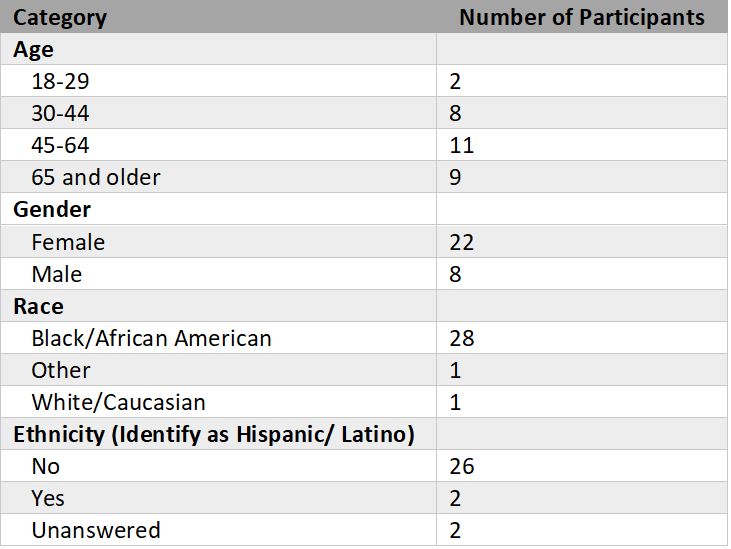Public Health & Prevention
Category: Abstract Submission
Public Health & Prevention II
575 - A Shared Definition of Health and Safety: Connection to Neighbors
Saturday, April 23, 2022
3:30 PM - 6:00 PM US MT
Poster Number: 575
Publication Number: 575.241
Publication Number: 575.241
Maria DeRenzo, UH Rainbow Babies & Children's Hospital, Cleveland, OH, United States; Sarah A. McAleer, UH, Rocky River, OH, United States; Paige Ewing, UH Rainbow Babies & Children's Hospital, Cleveland, OH, United States; Tashyana Copeland-Smith, UH Rainbow Babies & Children's Hospital, Cleveland, OH, United States; Rebecca Baas, UH Rainbow Babies & Children's Hospital, Cleveland, OH, United States; Sarah D. Ronis, Case Western Reserve University School of Medicine, Cleveland, OH, United States

Sarah D. Ronis, MD, PhD (she/her/hers)
Associate Professor
Case Western Reserve University School of Medicine
Cleveland, Ohio, United States
Presenting Author(s)
Background: Amid mounting evidence for impact of social determinants on health outcomes is growing recognition that place matters. In the historically red-lined neighborhoods surrounding Midtown Cleveland Ohio, a Neighborhood Vision Plan (NVP) created in 2020 with input from Midtown businesses, service organizations, and anchor healthcare institutions, centered goals around health equity and safety. It was unclear whether NVP goals were concordant with residents’ perspectives on proposed neighborhood transformation and its potential impact on their health.
Objective: To develop resident-centered definitions of health and safety and identify opportunities for furthering health-promoting interventions in the neighborhood.
Design/Methods: Spatial Video Geonarratives (audio-recorded semi-structured interviews combined with Geographic Information Systems and photo-video documentation of neighborhood assets and detractors) with participants recruited from one of several community organizations or through snowball sampling. Walking interview methodology elicited participants’ perspectives on the neighborhood, health, and safety (Table 1), with walks starting at a location of their choice and proceeding along a route at a pace they selected, followed by a questionnaire documenting demographics, key neighborhood locations not visited during the walk, and the Abbreviated Place Attachment Survey (APAS). Narrative data was thematically coded using content analysis. Descriptive statistics summarized participant demographics and APAS responses.
Results: 30 interviews were completed July-September 2021 (See Table 2). Participants had resided in the neighborhood on average 18 years (range 2 months-50 years). Definitions of a healthy neighborhood were very similar to definitions of a safe neighborhood, with differences by age group as to whether this neighborhood met their definition. A healthy neighborhood was defined as “enjoying your neighborhood”, “keeping your neighborhood up”, where residents “come together” and “people participate, “where you can see your neighbors sitting on their porches again”. They described a safe neighborhood as “a close knit area” because “when people know you, they tend to look out for you”. Conclusion(s): Residents define both a healthy neighborhood and a safe neighborhood in terms of the connection between residents and knowing one another’s neighbor. Interventions that aim to promote health equity for populations residing in under-invested neighborhoods should focus on strategies that increase connection and familiarity among residents.
Table 1: Exemplar semi-structured interview prompts
Table 2: Participant demographics
Objective: To develop resident-centered definitions of health and safety and identify opportunities for furthering health-promoting interventions in the neighborhood.
Design/Methods: Spatial Video Geonarratives (audio-recorded semi-structured interviews combined with Geographic Information Systems and photo-video documentation of neighborhood assets and detractors) with participants recruited from one of several community organizations or through snowball sampling. Walking interview methodology elicited participants’ perspectives on the neighborhood, health, and safety (Table 1), with walks starting at a location of their choice and proceeding along a route at a pace they selected, followed by a questionnaire documenting demographics, key neighborhood locations not visited during the walk, and the Abbreviated Place Attachment Survey (APAS). Narrative data was thematically coded using content analysis. Descriptive statistics summarized participant demographics and APAS responses.
Results: 30 interviews were completed July-September 2021 (See Table 2). Participants had resided in the neighborhood on average 18 years (range 2 months-50 years). Definitions of a healthy neighborhood were very similar to definitions of a safe neighborhood, with differences by age group as to whether this neighborhood met their definition. A healthy neighborhood was defined as “enjoying your neighborhood”, “keeping your neighborhood up”, where residents “come together” and “people participate, “where you can see your neighbors sitting on their porches again”. They described a safe neighborhood as “a close knit area” because “when people know you, they tend to look out for you”. Conclusion(s): Residents define both a healthy neighborhood and a safe neighborhood in terms of the connection between residents and knowing one another’s neighbor. Interventions that aim to promote health equity for populations residing in under-invested neighborhoods should focus on strategies that increase connection and familiarity among residents.
Table 1: Exemplar semi-structured interview prompts

Table 2: Participant demographics

